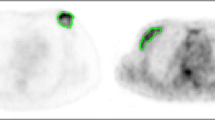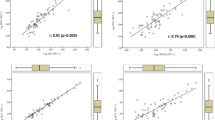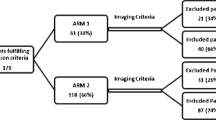Abstract
Purpose
The study was designed to evaluate 1) the relationship between PET image textural features (TFs) and SUVs, metabolic tumour volume (MTV), total lesion glycolysis (TLG) and tumour characteristics in a large prospective and homogenous cohort of oestrogen receptor-positive (ER+) breast cancer (BC) patients, and 2) the capability of those parameters to predict response to neoadjuvant chemotherapy (NAC).
Methods
171 consecutive patients with large or locally advanced ER+ BC without distant metastases underwent an 18F-FDG PET examination before NAC. The primary tumour was delineated with an adaptive threshold segmentation method. Parameters of volume, intensity and texture (entropy, homogeneity, contrast and energy) were measured and compared with tumour characteristics determined on pre-treatment breast biopsy (Wilcoxon rank-sum test). The correlation between PET-derived parameters was determined using Spearman’s coefficient. The relationship between PET features and pathological findings was determined using the Wilcoxon rank-sum test.
Results
Spearman’s coefficients between SUVmax and TFs were 0.43, 0.24, -0.43 and -0.15 respectively for entropy, homogeneity, energy and contrast; they were higher between MTV and TFs: 0.99, 0.86, -0.99 and -0.87. All TFs showed a significant association with the histological type (IDC vs. ILC; 0.02 < P < 0.03) but didn’t with immunohistochemical characteristics. SUVmax and TLG predicted the pathological response (P = 0.0021 and P = 0.02 respectively); TFs didn’t (P: 0.27, 0.19, 0.94, 0.19 respectively for entropy, homogeneity, energy and contrast).
Conclusions
The correlation of TFs was poor with SUV parameters and high with MTV. TFs showed a significant association with the histological type. Finally, while SUVmax and TLG were able to predict response to NAC, TFs failed.




Similar content being viewed by others
References
Perou CM, Sorlie T, Eisen MB, Van De Rijn M, Jeffrey SS, Rees CA, et al. Molecular portraits of human breast tumours. Nature. 2000;533:747–52.
NCCN. Clinical Pratice Guidelines on Oncology - Breast Cancer. 2015.
Lips EH, Mulder L, de Ronde JJ, Mandjes IAM, Vincent A, Vrancken Peeters MTFD, et al. Neoadjuvant chemotherapy in ER+ HER2− breast cancer: response prediction based on immunohistochemical and molecular characteristics. Breast Cancer Res Treat. 2012;131:827–36.
Groheux D, Hindié E, Delord M, Giacchetti S, Hamy A, Bazelaire C De, et al. Prognostic Impact of 18 FDG-PET-CT Findings in Clinical Stage III and IIB Breast Cancer. J. Natl. Cancer Inst. 2012;1879–87.
Groheux D, Cochet A, Humbert O, Alberini J-L, Hindié E, Mankoff D. 18F-FDG PET/CT for Staging and Restaging of Breast Cancer. J. Nucl. Med. Off. Publ. Soc. Nucl. Med. 2016;57 Suppl 1:17S–26S.
Humbert O, Berriolo-Riedinger A, Cochet A, Gauthier M, Charon-Barra C, Guiu S, et al. Prognostic relevance at 5 years of the early monitoring of neoadjuvant chemotherapy using (18)F-FDG PET in luminal HER2-negative breast cancer. Eur J Nucl Med Mol Imaging. 2014;41:416–27.
Aogi K, Kadoya T, Sugawara Y, Kiyoto S, Shigematsu H, Masumoto N, et al. Utility of (18)F FDG-PET/CT for predicting prognosis of luminal-type breast cancer. Breast Cancer Res Treat. 2015;150:209–17.
Groheux D, Sanna A, Majdoub M, Cremoux P de, Giacchetti S, Teixeira L, et al. Baseline Tumor 18F-FDG Uptake and Modifications After 2 Cycles of Neoadjuvant Chemotherapy Are Prognostic of Outcome in ER+/HER2- Breast Cancer. J. Nucl. Med. 2015;56.
Groheux D, Giacchetti S, Moretti J-L, Porcher R, Espié M, Lehmann-Che J, et al. Correlation of high 18F-FDG uptake to clinical, pathological and biological prognostic factors in breast cancer. Eur J Nucl Med Mol Imaging. 2011;38:426–35.
Groheux D, Hatt M, Hindié E, Giacchetti S, de Cremoux P, Lehmann-Che J, et al. Estrogen receptor-positive/human epidermal growth factor receptor 2-negative breast tumors: early prediction of chemosensitivity with (18)F-fluorodeoxyglucose positron emission tomography/computed tomography during neoadjuvant chemotherapy. Cancer. 2013;119:1960–8.
Hatt M, Groheux D, Martineau A, Espié M, Hindié E, Giacchetti S, et al. Comparison between 18F-FDG PET image-derived indices for early prediction of response to neoadjuvant chemotherapy in breast cancer. J Nucl Med. 2013;54:341–9.
Tixier F, Cheze Le Rest C, Hatt M, Albarghach N, Pradier O, Metges J-P, et al. Intratumor heterogeneity characterized by textural features on baseline 18F-FDG PET images predicts response to concomitant radiochemotherapy in esophageal cancer. J Nucl Med. 2011;52:369–78.
Cook GJR, O’Brien ME, Siddique M, Chicklore S, Loi HY, Sharma B, et al. Non–Small Cell Lung Cancer Treated with Erlotinib: Heterogeneity of 18F-FDG Uptake at PET—Association with Treatment Response and Prognosis. Radiology. 2015;276:883–93.
Eary JF, Sullivan FO, Sullivan JO, Conrad EU. Spatial Heterogeneity in Sarcoma 18 F-FDG Uptake as a Predictor of Patient Outcome. J Nucl Med. 2008;49:1973–9.
Soussan M, Orlhac F, Boubaya M, Zelek L, Ziol M, Eder V, et al. Relationship between tumor heterogeneity measured on FDG-PET/CT and pathological prognostic factors in invasive breast cancer. PLoS One. 2014;9:e94017.
Son SH, Kim D-H, Hong CM, Kim C-Y, Jeong SY, Lee S-W, et al. Prognostic implication of intratumoral metabolic heterogeneity in invasive ductal carcinoma of the breast. BMC Cancer. 2014;14:585.
Groheux D, Majdoub M, Tixier F, Le Rest CC, Martineau A, Merlet P, et al. Do clinical, histological or immunohistochemical primary tumour characteristics translate into different 18F-FDG PET/CT volumetric and heterogeneity features in stage II/III breast cancer? Eur J Nucl Med Mol Imaging. 2015;42:1682–91.
Buvat I, Orlhac F, Soussan M. Tumor Texture Analysis in PET: Where Do We Stand? J Nucl Med. 2015;56:1642–4.
Hatt M, Tixier F, Pierce L, Kinahan PE, Le Rest CC, Visvikis D. Characterization of PET/CT images using texture analysis: the past, the present… any future? Eur. J. Nucl. Med. Mol. Imaging. 2016;1–15.
Bundschuh R a, Dinges J, Neumann L, Seyfried M, Zsótér N, Papp L, et al. Textural Parameters of Tumor Heterogeneity in 18F-FDG PET/CT for Therapy Response Assessment and Prognosis in Patients with Locally Advanced Rectal Cancer. J. Nucl. Med. 2014;55:891–7.
Orlhac F, Soussan M, Maisonobe J-A, Garcia CA, Vanderlinden B, Buvat I. Tumor texture analysis in 18F-FDG PET: relationships between texture parameters, histogram indices, standardized uptake values, metabolic volumes, and total lesion glycolysis. J Nucl Med. 2014;55:414–22.
Hatt M, Majdoub M, Vallières M, Tixier F, Le Rest CC, Groheux D, et al. 18F-FDG PET uptake characterization through texture analysis: investigating the complementary nature of heterogeneity and functional tumor volume in a multi-cancer site patient cohort. J Nucl Med. 2015;56:38–44.
Daisne J-F, Sibomana M, Bol A, Doumont T, Lonneux M, Grégoire V. Tri-dimensional automatic segmentation of PET volumes based on measured source-to-background ratios: influence of reconstruction algorithms. Radiother Oncol. 2003;69:247–50.
Vauclin S, Doyeux K, Hapdey S, Vera P. Development of a generic thresholding algorithm for the delineation of 18 FDG-PET-positive tissue: application to the comparison of three thresholding. Phys Med Biol. 2009;54:6901–16.
Wahl RL, Jacene H, Kasamon Y, Lodge MA. From RECIST to PERCIST: Evolving Considerations for PET Response Criteria in Solid Tumors Richard. J Nucl Med. 2009;50:1–50.
Kurani AS, Xu D, Furst J, Raicu DS. Co-occurrence matrices for volumetric data. 7th IASTED Int. Conf. Comput. Graph. Imaging, Kauai. 2004.
Tixier F, Hatt M, Le Rest CC, Le Pogam A, Corcos L, Visvikis D. Reproducibility of tumor uptake heterogeneity characterization through textural feature analysis in 18F-FDG PET. J Nucl Med. 2012;53:693–700.
Hatt M, Tixier F, Cheze Le Rest C, Pradier O, Visvikis D. Robustness of intratumour 18F-FDG PET uptake heterogeneity quantification for therapy response prediction in oesophageal carcinoma. Eur J Nucl Med Mol Imaging. 2013;40:1662–71.
Cortazar P, Zhang L, Untch M, Mehta K, Costantino JP, Wolmark N, et al. Pathological complete response and long-term clinical benefit in breast cancer : the CTNeoBC pooled analysis. Lancet. 2014;384:164–72.
Haralick RM, Shanmugam K, Dinstein I. Textural Features for Image Classification. IEEE Trans Syst Man Cybern. 1973;3:610–21.
Aerts HJWL, Velazquez ER, Leijenaar RTH, Parmar C, Grossmann P, Cavalho S, et al. Decoding tumour phenotype by noninvasive imaging using a quantitative radiomics approach. Nat Commun. 2014;5:4006.
Groheux D, Hindié E. Is 18FDG uptake useful to decide on chemotherapy in ER+/HER2- breast cancer? Eur J Nucl Med Mol Imaging. 2016;43:1571–3.
Brooks FJ, Grigsby PW. The effect of small tumor volumes on studies of intratumoral heterogeneity of tracer uptake. J Nucl Med. 2014;55:37–42.
Orlhac F, Thézé B, Soussan M, Boisgard R, Buvat I. Multi-scale texture analysis: from 18F-FDG PET images to pathological slides. J. Nucl. Med. 2016
Zaidi H, El Naqa I. PET-guided delineation of radiation therapy treatment volumes: a survey of image segmentation techniques. Eur J Nucl Med Mol Imaging. 2010;37:2165–87.
Dunnwald LK, Gralow JR, Ellis GK, Livingston RB, Linden HM, Specht JM, et al. Tumor metabolism and blood flow changes by positron emission tomography: relation to survival in patients treated with neoadjuvant chemotherapy for locally advanced breast cancer. J Clin Oncol Off J Am Soc Clin Oncol. 2008;26:4449–57.
Tixier F, Vriens D, Cheze- Le Rest C, Hatt M, Disselhorst JA, Oyen WJG, et al. Comparison of tumor uptake heterogeneity characterization between static and parametric 18F-FDG PET images in Non-Small Cell Lung Cancer. J Nucl Med. 2016;57:1033–9.
Author information
Authors and Affiliations
Corresponding author
Ethics declarations
Funding
This study was in part supported by an academic grant (“Translational research in oncology” INCa-DHOS-5697).
Conflicts of interest
All the authors declared no conflicts of interest.
Research involving human participants and/or animals
All procedures performed in studies involving human participants were in accordance with the ethical standards of the institutional and/or national research committee and with the principles of the 1964 Declaration of Helsinki and its later amendments or comparable ethical standards.
Informed consent
For this ancillary study, written consent was not required.
Rights and permissions
About this article
Cite this article
Lemarignier, C., Martineau, A., Teixeira, L. et al. Correlation between tumour characteristics, SUV measurements, metabolic tumour volume, TLG and textural features assessed with 18F-FDG PET in a large cohort of oestrogen receptor-positive breast cancer patients. Eur J Nucl Med Mol Imaging 44, 1145–1154 (2017). https://doi.org/10.1007/s00259-017-3641-4
Received:
Accepted:
Published:
Issue Date:
DOI: https://doi.org/10.1007/s00259-017-3641-4




